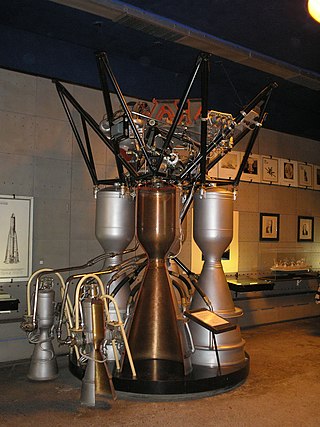Top Qs
Timeline
Chat
Perspective
RD-107
Russian rocket engine From Wikipedia, the free encyclopedia
Remove ads
The RD-107 (Russian: Ракетный Двигатель-107, romanized: Raketnyy Dvigatel-107, lit. 'Rocket Engine 107') and its sibling, the RD-108, are a type of rocket engine used on the R-7 rocket family. RD-107 engines are used in each booster and the RD-108 is used in the central core. The engines have four main combustion chambers (each with a nozzle) and either two (RD-107) or four (RD-108) vernier chambers.
The engines were first developed in the mid-1950s to launch the R-7 Semyorka, the first intercontinental ballistic missile. The R-7 was later adapted into space launch vehicles and the engines have been improved over several generations. The most recent versions are the RD-107A and RD-108A engines are used to launch the Soyuz-2, which is in active service as of 2024[update].
Remove ads
Design
Summarize
Perspective

The RD-107 was designed under the direction of Valentin Glushko at the Experimental Design Bureau (OKB-456) between 1954 and 1957. It uses liquid oxygen and kerosene as propellants operating in a gas-generator cycle. As was typical by all the descendants of the V-2 rocket technology, the turbine is driven by steam generated by catalytic decomposition of H₂O₂. The steam generator uses solid F-30-P-G catalyst. This consists of variable-sized porous oxidized iron pellets, half of which are coated in a mixture of potassium permanganate and sodium. Each engine uses four fixed main combustion chambers. The RD-107 has an additional two vernier combustion chambers that can thrust vector in a single plane to supply attitude control. The RD-108 has four verniers to supply full vector control to the Blok-A stage. The single-axle turbopump unit includes the steam driven turbine, an oxidizer pump, a fuel pump, and a nitrogen gas generator for tank pressurization.[3]
The RD-107 engines are used in each of the boosters of the Soyuz-2 rocket, and a single RD-108 is used in the Blok-A stage (the central 1st stage).
One important innovation of this engine was the capability to use variable mixture ratio between fuel and oxidizer. The natural variations in manufacturing between each engine meant that without an active propellant consumption control, each booster could deplete oxygen and fuel at a different rate. This might result in as much as tens of tonnes of unused propellant near the end of the burn. It would generate enormous stress on the structure and cause difficulties in steering due to the mass imbalance. The mixture ratio control system was developed to ensure the simultaneous consumption of propellant mass among the four R-7 boosters.[3][7]
Remove ads
Production
The RD-107 and RD-108 engines are produced at the JSC Kuznetsov plant in Samara, Russia, under the supervision of the Privolzhskiy branch of NPO Energomash, also known as the Volga branch.[1][3][5] The Privolzhsky branch was organized as a branch of OKB-456 in 1958, specifically for the manufacture of RD-107 and RD-108 engines. The branch was led by Y.D. Solovjev until 1960, then by R.I. Zelenev until 1975, then by A.F. Udalov until 1978, and is currently led by A.A. Ganin.[8]
Remove ads
Versions
Summarize
Perspective

RD-107 variants
Modifications to the RD-107 design have led to production of several distinct versions of the engine:
- RD-107 (GRAU index: 8D74): Original version.[4] Used on ICBM versions of the R-7, Sputnik, Luna, and Vostok rockets.[3]
- RD-107K (GRAU index: 8D74K): Improved version of the RD-107. Used on the Molniya, Vostok-2, Vostok-2M, and Voskhod rockets.[3]
- RD-107MM (GRAU index: 8D728 or 8D74M): Increased thrust over the RD-107K by 5%.[4] Used on the Molniya-M and Soyuz universally adopted on R-7 vehicles in 1966.[3]
- RD-117 (GRAU index: 11D511): Improved structural changes.[4] Used on the Soyuz-U and Soyuz-U2 rockets.[3]
- RD-107А (GRAU index: 14D22): Improved version of the RD-117 with new injector design. Replaced 260 two-component centrifugal injectors with more than a thousand one-component injectors that provided finer aeration of propellant for more thorough burning, reducing high-frequency vibrations inside the combustion chambers and increasing specific impulse by about 5 seconds (0.049 km/s), or five percent.[9] Used on the Soyuz-FG, Soyuz-ST-A and Soyuz-ST-B rockets.[3]
- RD-107А (GRAU index: 14D22KhZ): Chemical ignited version of the RD-107A. Used on the Soyuz-2.1a and Soyuz-2.1b rockets.[3][5][10]
RD-108 variants
Similar modifications have led to several distinct versions of the RD-108:
- RD-108 (GRAU index: 8D75): Original version.[4] Used on the R-7, Sputnik, Vostok and Voskhod rockets.[3]
- RD-108K (GRAU index: 8D75K): Improved version of the RD-108. Used on the Molniya rocket.[3]
- RD-108MM (GRAU index: 8D727 or 8D75M): Increased thrust over the RD-108K by 5%.[4] Used on the Molniya-M and Soyuz rockets.[3]
- RD-118 (GRAU index: 11D512): Improved structural changes.[4] Used on the Soyuz-U rocket.[3]
- RD-118PF (GRAU index: 11D512PF): Variant of the RD-118 optimized to run on Syntin fuel rather than RG-1. It used selected injectors to minimize instabilities without changing constructions methods, but it required a significant number of engines produced to get injectors that complied with the stringent specifications. Used on the Soyuz-U2 rocket.[3][11]
- RD-108A (GRAU index: 14D21): Improved version of the RD-118 with new injector design. Replaced 260 two-component centrifugal injectors with more than a thousand one-component injectors that provided finer aeration of propellant for more thorough burning, reducing high-frequency vibrations inside the combustion chambers and increasing specific impulse by about 5 seconds (0.049 km/s), or five percent.[9] Used on the Soyuz-FG, Soyuz-ST-A and Soyuz-ST-B rockets.[3]
- RD-108A (GRAU index: 14D21KhZ): Chemical ignited variant of the RD-108A. Used on the Soyuz-2.1a and Soyuz-2.1b rockets.[3][5][10]
Work on the 14D21 and 14D22 engines started in 1986, with a preliminary design completed in 1993. These engines incorporate a new injector head design to increase specific impulse. The first launch of a Progress cargo spacecraft using a launch vehicle equipped with these engines took place in May 2001. The first human spaceflight launch utilizing these engines took place in October 2002.[5]
Remove ads
See also
References
External links
Wikiwand - on
Seamless Wikipedia browsing. On steroids.
Remove ads

